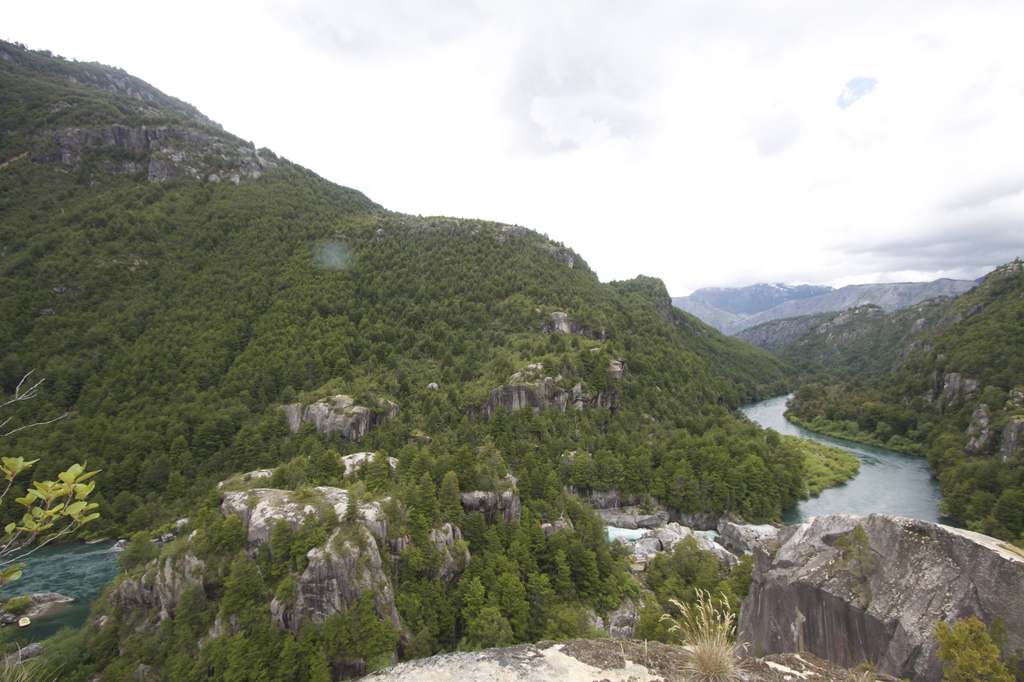
The Futaleufú river in southern Region X (Los Lagos). Photo © Zachary Collier of Northwest Rafting Company.
Over the past decade-plus, the only environmental issue to rival forest preservation has been Chile’s wild rivers. The struggle over water rights and development will likely continue well into the future. This complex matter encompasses indigenous rights, energy use, air and water pollution, and economic development, and there’s no easy answer. Chile is poor in fossil-fuel resources, obtaining less than 5 percent of its own crude petroleum consumption and a small amount of coal from domestic sources in the southern region of Magallanes. Both industry and transportation rely on imported fuels, and the capital of Santiago has paid the price with some of the world’s most polluted urban skies. For both economic and environmental reasons, Chile would like to increase its supply of relatively clean hydroelectricity by building dams to hold the spring snowmelt from its transverse rivers.For both economic and environmental reasons, Chile would like to increase its supply of relatively clean hydroelectricity by building dams to hold the spring snowmelt from its transverse rivers. In the course of constructing a series of dams on the Río Biobío, though, the Spanish-Chilean utility Endesa ran afoul of a few determined Pehuenche Indian families who, backed by the 1992 Ley Indígena (Indigenous Law), vowed that “The only way we will be taken away from here, is once we are dead.” In their opposition to the Ralco dam, one of half a dozen planned for the area, the Pehuenche were backed by conservationists and recreationists who saw the Biobío as one of the world’s top streamside habitats and white-water rivers, even after construction of Endesa’s Pangue dam a few years ago.Endesa won that battle with an enormous buyout, but the Biobío was not the last threatened Chilean river. Many rafters and kayakers consider the Futaleufú, in southern Region X near the Argentine border, the world’s greatest white-water challenge, but Endesa and other energy companies have options on its water rights, despite its isolation. Near the Region XI town of Cochrane, Endesa and its Chilean partner Colbun have plans to build a series of four massive dams on the nearly pristine Río Baker and Río Pascua in the so-called HydroAysén project; these would not only affect the local environment, but would require clear-cutting large swaths of forest for more than a thousand kilometers of transmission lines to connect them to the national grid.
In mid-2012, the Baker and Pascua got a reprieve when minority partner Colbun decided, because of unfavorable political circumstances — primarily the plunging popularity of President Sebastián Piñera — to shelve the project. Almost certainly, though, it will be resurrected under a succeeding government.
Environmental advocates argue that sustainable activities, such as rafting and kayaking, flyfishing, and even salmon farming (a bogeyman to some conservationists) are more appropriate uses than massive dams and deforestation. To promote their cause, Chilean conservation organizations such as the Grupo de Acción por el Biobío (Biobío Action Group) have made common cause with overseas affiliates such as the International Rivers Network (2150 Allston Way, Suite 300, Berkeley, CA 94704, tel. 510/848-1155) and Futaleufú Riverkeeper (tel. 065/562746 in Chile; tel. 914/357-4837 in the U.S.). U.S. conservationist Robert F. Kennedy Jr. has brought several high-profile groups to raft the “Fu” and has questioned the long-term viability of Endesa’s plans.
Excerpted from the Fourth Edition of Moon Chile.